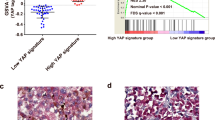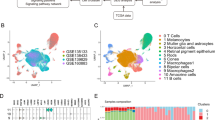Abstract
Objective
The purpose of our present study was to investigate the expression of cation transport regulator-like protein 1 (CHAC1) in uveal melanoma (UM) tissues and its function in UM progression.
Methods
The mRNA expression of CHAC1 in UM tissues and its prognostic value were investigated based on Gene Expression Omnibus database and The Cancer Genome Atlas database. SP6.5 and M23 UM cell lines with depleted CHAC1 were constructed using small interfering RNA. The viability and migration ability of SP6.5 and M23 UM cells were determined by MTT and wound healing assays, respectively. Western blot was conducted to test the influences of CHAC1 depletion on PI3K signaling pathway.
Results
Higher expression of CHAC1 was observed in the UM tissues from patients with liver metastases compared to that from patients without metastases. High CHAC1 expression was correlated with poor prognostic and was an independent predictor for UM patients. Depletion of CHAC1 remarkably inhibited the proliferation and motility of SP6.5 and M23 UM cells. Moreover, the ratios of p-AKT/AKT and p-mTOR/mTOR were reduced notably after silencing CHAC1.
Conclusions
Our results suggested that CHAC1 functioned as a facilitator in UM cell proliferation and migration and possessed the potential to be a predictor as well as a therapeutic target for UM patients.




Similar content being viewed by others
References
Siegel R, Ma J, Zou Z, Jemal A, Ward E, Xu J, Siegael R, Desantis C, Zoy Z (2014) Cancer statistics, 2014. CA Cancer J Clin 62(1):10
Jiang Z, Yu F, Li M (2018) Upregulation of BCL2 19 kD protein-interacting protein 3 (BNIP3) is predictive of unfavorable prognosis in uveal melanoma. Med Sci Monit 24:4711–4717
Tarlan B, Kıratlı H (2016) Uveal melanoma: current trends in diagnosis and management. Turk J Ophthalmol 46(3):123–137
Damato B (2012) Progress in the management of patients with uveal melanoma. The 2012 Ashton Lecture. Eye 26(9):1157
Jager M, Brouwer N, Esmaeli B (2018) The Cancer Genome Atlas Project: an integrated molecular view of uveal melanoma. Ophthalmology 125(8):1139–1142
Spagnolo F, Caltabiano G, Queirolo P (2012) Uveal melanoma. Cancer Treat Rev 38(5):549–553
Goebel G, Berger R, Strasak AM, Egle D, Müllerholzner E, Schmidt S, Rainer J, Presul E, Parson W, Lang S (2012) Elevated mRNA expression of CHAC1 splicing variants is associated with poor outcome for breast and ovarian cancer patients. Br J Cancer 106(1):189–198
Zhang XD, Jiang CC, Wang YF, Wade M, Averykiejda K, Hersey P (2008) The unfolded protein response differentially regulates sensitivities of human melanoma cells to chemotherapeutic drugs. Cancer Res 68:715
Shuda M, Kondoh N, Imazeki N, Tanaka K, Okada T, Mori K, Hada A, Arai M, Wakatsuki T, Matsubara O (2003) Activation of the ATF6, XBP1 and grp78 genes in human hepatocellular carcinoma: a possible involvement of the ER stress pathway in hepatocarcinogenesis. J Hepatol 38(5):605–614
Scriven P, Brown N, Pockley A, Wyld L (2007) The unfolded protein response and cancer: a brighter future unfolding? J Mol Med 85(4):331–341
Jahn B, Arvandi M, Rochau U, Fiegl H, Goebel G, Marth C, Siebert U (2017) Development of a novel prognostic score for breast cancer patients using mRNA expression of CHAC1. J Comp Eff Res 6(7):563–574
Chen P, Shen W, Shih C, Ho K, Cheng C, Lin C, Lee C, Liu A, Chen K (2017) The CHAC1-inhibited Notch3 pathway is involved in temozolomide-induced glioma cytotoxicity. Neuropharmacology 116:300–314
Stelzer Y, Yanuka O, Benvenisty N (2011) Global analysis of parental imprinting in human parthenogenetic induced pluripotent stem cells. Nat Struct Mol Biol 18(6):735–741
Buchholz M, Braun M, Heidenblut A, Kestler H, Klöppel G, Schmiegel W, Hahn S, Lüttges J, Gress T (2005) Transcriptome analysis of microdissected pancreatic intraepithelial neoplastic lesions. Oncogene 24(44):6626–6636
Zhang Y, Qiao H, Zhou Y, Hong L, Chen J (2018) Fibrinogen-like-protein 1 promotes the invasion and metastasis of gastric cancer and is associated with poor prognosis. Mol Med Rep 18(2):1465–1472
Livak KJ, Schmittgen TD (2001) Analysis of relative gene expression data using real-time quantitative PCR and the 2(-delta delta C(T)) method. Methods 25(4):402–408
Wang M, Li X, Zhang J, Yang Q, Chen W, Jin W, Huang YR, Yang R, Gao WQ (2017) AHNAK2 is a novel prognostic marker and oncogenic protein for clear cell renal cell carcinoma. Theranostics 7(5):1100–1113
Xu W, Yang Z, Lu N (2015) A new role for the PI3K/Akt signaling pathway in the epithelial-mesenchymal transition. Cell Adhes Migr 9(4):317–324
Mungrue IN, Pagnon J, Kohannim O, Gargalovic PS, Lusis AJ (2009) CHAC1/MGC4504 is a novel proapoptotic component of the unfolded protein response, downstream of the ATF4-ATF3-CHOP cascade. J Immunol 182(1):466
Scriven P, Coulson S, Haines R, Balasubramanian S, Cross S, Wyld L (2009) Activation and clinical significance of the unfolded protein response in breast cancer. Br J Cancer 101(10):1692–1698
Sun Y, Atmadibrata B, Yu D, Wong M, Liu B, Ho N, Ling D, Tee AE, Wang J, Mungrue IN, Liu PY (2017) Upregulation of LYAR induces neuroblastoma cell proliferation and survival. Cell Death Differ 24(9):1645–1654
Pompura S, Dominguez-Villar M (2018) The PI3K/AKT signaling pathway in regulatory T-cell development, stability, and function. J Leukoc, Biol
Porta C, Paglino C, Mosca A (2014) Targeting PI3K/Akt/mTOR signaling in cancer. Front Oncol 4(4):64
Fruman DA, Chiu H, Hopkins BD, Bagrodia S, Cantley LC, Abraham RT (2017) The PI3K pathway in human disease. Cell 170(4):605
Li Y, Sun D, Sun W, Yin D (2019) Ras-PI3K-AKT signaling promotes the occurrence and development of uveal melanoma by downregulating H3K56ac expression. J Cell Physiol. https://doi.org/10.1002/jcp.28261
Ye M, Hu D, Tu L, Zhou X, Lu F, Wen B, Wu W, Lin Y, Zhou Z, Qu J (2008) Involvement of PI3K/Akt signaling pathway in hepatocyte growth factor-induced migration of uveal melanoma cells. Invest Ophthalmol Vis Sci 49(2):497–504
Author information
Authors and Affiliations
Corresponding author
Ethics declarations
Conflict of interest
The authors declare no conflicts of interest.
Additional information
Publisher's Note
Springer Nature remains neutral with regard to jurisdictional claims in published maps and institutional affiliations.
Rights and permissions
About this article
Cite this article
Liu, Y., Li, M., Shi, D. et al. Higher expression of cation transport regulator-like protein 1 (CHAC1) predicts of poor outcomes in uveal melanoma (UM) patients. Int Ophthalmol 39, 2825–2832 (2019). https://doi.org/10.1007/s10792-019-01129-1
Received:
Accepted:
Published:
Issue Date:
DOI: https://doi.org/10.1007/s10792-019-01129-1




